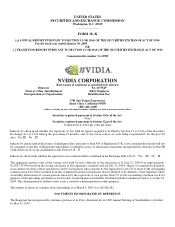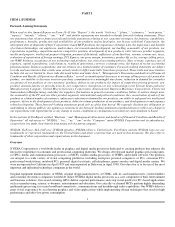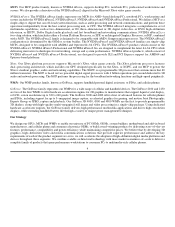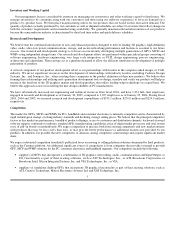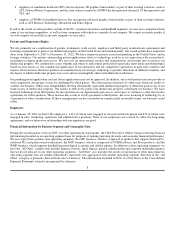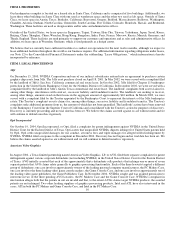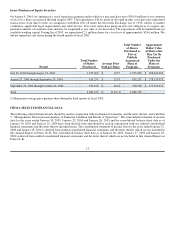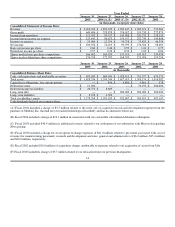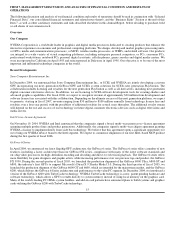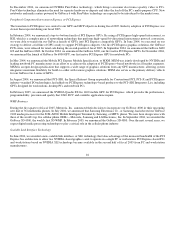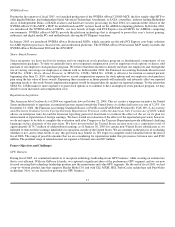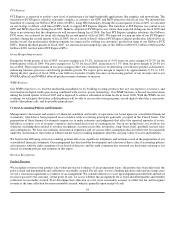NVIDIA 2005 Annual Report Download - page 14
Download and view the complete annual report
Please find page 14 of the 2005 NVIDIA annual report below. You can navigate through the pages in the report by either clicking on the pages listed below, or by using the keyword search tool below to find specific information within the annual report.
•suppliers of standalone notebook GPUs that incorporate 3D graphics functionality as part of their existing solutions, such as
ATI, Silicon Motion Corporation, and the joint venture formed by SONICblue Incorporated (formerly S3 Incorporated) and
VIA; and
•suppliers of WMPs for handheld devices that incorporate advanced graphics functionality as part of their existing solutions,
such as ATI, Renesas Technology, Broadcom and Seiko−Epson.
If and to the extent we offer products outside of the PC, consumer electronics and handheld segments, we may face competition from
some of our existing competitors, as well as from companies with which we currently do not compete. We cannot accurately predict if
we will compete successfully in any new segments we may enter.
Patents and Proprietary Rights
We rely primarily on a combination of patents, trademarks, trade secrets, employee and third−party nondisclosure agreements and
licensing arrangements to protect our intellectual property in the United States and internationally. Our issued patents have expiration
dates from September 4, 2007 to December 11, 2022. We have numerous patents issued and pending in the United States and in
foreign countries. Our patents and pending patent applications relate to technology used by us in connection with our products,
including our digital media processors. We also rely on international treaties and organizations and foreign laws to protect our
intellectual property. We continuously assess whether and where to seek formal protection for particular innovations and technologies
based on such factors as: the commercial significance of our operations and our competitors' operations in particular countries and
regions; the location in which our products are manufactured; our strategic technology or product directions in different countries; and
the degree to which intellectual property laws exist and are meaningfully enforced in different jurisdictions.
Our pending patent applications and any future applications may not be approved. In addition, any issued patents may not provide us
with competitive advantages or may be challenged by third parties. The enforcement of patents by others may harm our ability to
conduct our business. Others may independently develop substantially equivalent intellectual property or otherwise gain access to our
trade secrets or intellectual property. Our failure to effectively protect our intellectual property could harm our business. We have
licensed technology from third parties for incorporation in our digital media processors, and expect to continue to enter into license
agreements for future products. These licenses may result in royalty payments to third parties, the cross licensing of technology by us
or payment of other consideration. If these arrangements are not concluded on commercially reasonable terms, our business could
suffer.
Employees
As of January 30, 2005 we had 2,101 employees, 1,231 of whom were engaged in research and development and 870 of whom were
engaged in sales, marketing, operations and administrative positions. None of our employees are covered by collective bargaining
agreements, and we believe our relationships with our employees are good.
Financial Information by Business Segment and Geographic Data
During the second quarter of fiscal 2005, our chief operating decision maker, the Chief Executive Officer, began reviewing financial
information presented on an operating segment basis for purposes of making operating decisions and assessing financial performance.
We now report three product−line operating segments: the GPU business, which is composed of products that support desktop PCs,
notebook PCs and professional workstations; the MCP business, which is composed of NVIDIA nForce and Xbox products; and the
WMP business, which supports handheld personal digital assistants and cellular phones. In addition to these operating segments, we
have the “All Other” category that includes human resources, legal, finance, general administration and corporate marketing expenses
that we do not allocate to our other operating segments. “All Other” also includes the results of operations of other miscellaneous
operating segments that are neither individually reportable, nor aggregated with another operating segment. Revenue in the “All
Other” category is primarily derived from sales of memory. The information included in Note 15 of the Notes to the Consolidated
Financial Statements is hereby incorporated by reference.
8


